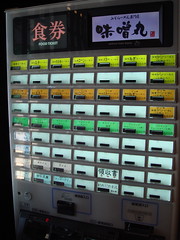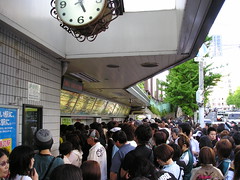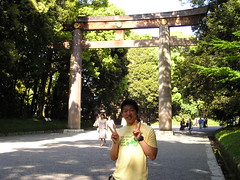InfoMofo
On Tokyo
May 06, 2006

After four days in Tokyo, on my last night here, it is difficult for me to summarize my opinions of Tokyo into one blog post. Tokyo is so many things at once, but I’ll try to break my reactions up, in the order that I experienced them.
Tokyo is terrifying
Landing in Narita Airport, I was exhausted after a 10 hour trip from Sydney (with a transfer in Hong Kong). A co-worker had already advised me which line to take (the Narita Express) which went directly to Ikebukuro, and I knew that my hotel was only one block away from the train station, so I thought I was pretty good. First of all, I didn’t realize how expensive the train in would be. Given that the New York Airport Shuttle runs 7 dollars, I was pretty shocked when I had to fork over 3300 yen for the ticket (about 30 USD). I also had not realized how long the train ride would be (about an hour and a half), and I realized during the long ride between the Tokyo and Ikebukuro terminals, that Tokyo is a much larger city than I had anticipated. Area-wise, it is so much larger than Manhattan, yet 5 or 6 of the major train stations are as packed (or more packed) than Times Square station.
Tokyo is not English-friendly
I quickly found that 50% of the written Japanese that I had been practicing in the workbook in the plane was pretty much useless to me… Most static signs use Kanji of course, rather than the hiragana phoenetic alphabet. Katakana was probably the most useful to know, and of the two kana-alphabets, the one I was the least familiar with after my 1 semester of Introductory Japanese in college. Though the train and subway stations are very good about having English signs, certain things like the fare-calculation maps above the subway ticket machines are in Kanji-only, so unless I had a secondary map with roomanji or hiragana on it, I would basically just take a stab in the dark. Even more difficult than the train stations were restaurants. When by myself, I found myself completely daunted at several places, where they didn’t have an English menu, a menu with pictures, or a single waiter that spoke any English, so I would basically scan the menu desperately for katakana phrases (like setto, keeki) or the very few kanji that i recognize from Chinese menus or my long-dusty mandarin classes; I basically tried to not order anything poisonous or sound like an idiot, and I probably ended up doing both. At one onigiri stand, when I realized that the “setto” that I had ordered required a choice of two different types of onigiri, I pointed at one of the onigiri in the case tentatively, and the girl looked at me, a little nervously, and in broken English said “uh… is… dangerous?“. I have no idea what she was talking about, but just in case I changed my order to the salmon (because I saw the girl rolling a salmon onigiri right at that moment), and an ume (because it was the only thing written in hiragana on the wall… and I hate ume). However, the food was all fantastic, and I was able to get more adventurous with food when I was with my friends who live here (I ate cow heart, raw cow’s liver, assorted beef cuts that my friends didn’t know the English word for, assorted raw fish that my friends didn’t know the English word for,
Tokyo is confusing
Even after 4 days, having mastered the JR lines, the privately-run Toyoko line, and the much-feared chikatetsu, I still don’t understand basic street addresses here. At several times I asked my friends what the names of certain streets were, and they told me that the streets didn’t have names. In fact, all of the maps I see of Tokyo never have street names on them, and the addresses given are some weird combination of numbers and district names. I’ll have to figure this out on another trip, but I’m still totally baffled by the addressing system here. It’s even worse than Florence (which has separate blue and red numbering counters for addresses (which increment independently of each other)).
Tokyo is hectic
Several different areas I went to (Akihabara, Shinjuku, Shibuya, Harajuku) had denser foot traffic than Times Square, and not the leisurely, ambling, photography happy tourists you see there, but rather crowds of business men, stylish women, funky-dressed girls, punky-dressed boys, all focused and walking with a purpose to some destination (well OK, in harajuku they just stand around, but that’s it’s own thing).
Tokyo is the fucking bomb
The people in Tokyo are just the coolest population you could imagine for a city of its size. Despite the aforementioned bedlam and Babel, the city is incredibly clean and the people are unerringly polite. At one juncture I was completely lost, and I asked a woman sitting down on a street bench how to get to Ebisu station. Though she spoke no English, she said something which I can only assume meant she was going in that direction, led me through a maze of streets, and then pointed me in a direction and said “go straight” in the best English she could muster. The food, though it may take some embarassing re-orders to get right, is just unbelievably good. The people here embrace technological innovation; you can see people of all ages using the public transportation, using the integrated features of their mobile phones, and the mass adoption of such technologies clearly spurs companies to innovate further.
There are so many small everyday things that strike you as incredibly efficient, and I don’t know if it’s just my tourist goggles, but I can’t help how notice how certain operations in Tokyo are streamlined through the use of technology, standardization, and just common sense, to really improve on small annoyances. The first thing I noticed is that on a reserved train, the conductor does not come by and punch every ticket. He has a computer that tells him which seats are bought, and then he only asks for tickets of people sitting in seats marked as unoccupied on his display. Though it’s not a technological thing, it also strikes me after being in both Australia and Tokyo, is that tipping is just an incredibly stupid custom. OK, I’m rambling now, but there is a lot to like about how things are done in Tokyo; there are so many things they do right here, that really make you think hard about some of the unnecessary bureaucracy we put up with every day.
All in all, I was completely blown away by Tokyo, and I will be coming back the first chance I get.
Written by Will who lives and works in New York. You should follow him on Bluesky.